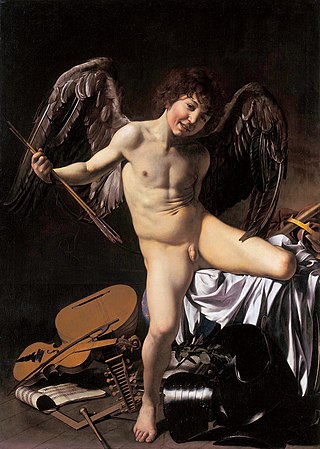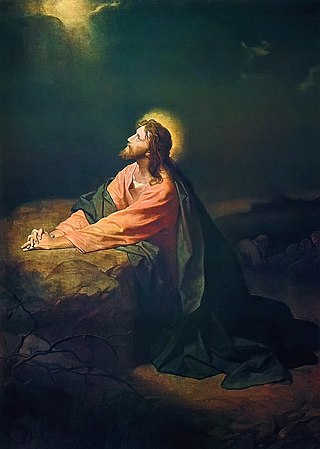
Michelangelo Merisi da Caravaggio, known mononymously as Caravaggio, was an Italian painter active in Rome for most of his artistic life. During the final four years of his life, he moved between Naples, Malta, and Sicily until his death. His paintings have been characterized by art critics as combining a realistic observation of the human state, both physical and emotional, with a dramatic use of lighting, which had a formative influence on Baroque painting.

Amor Vincit Omnia in Latin, known in English by a variety of names including Amor Victorious, Victorious Cupid, Love Triumphant, Love Victorious, or Earthly Love) is a painting by the Italian Baroque artist Caravaggio.

The agony in the Garden of Gethsemane is an episode in the life of Jesus, which occurred after the Last Supper and before his betrayal and arrest, all part of the Passion of Jesus leading to his crucifixion and death. This episode is described in the three Synoptic Gospels in the New Testament. According to these accounts, Jesus, accompanied by Peter, John and James, enters the garden of Gethsemane on the Mount of Olives where he experiences great anguish and prays to be delivered from his impending suffering, while also accepting God's will.

The Crucifixion of Saint Peter is a work by Michelangelo Merisi da Caravaggio, painted in 1601 for the Cerasi Chapel of Santa Maria del Popolo in Rome. Across the chapel is a second Caravaggio work depicting the Conversion of Saint Paul on the Road to Damascus (1601). On the altar between the two is the Assumption of the Virgin Mary by Annibale Carracci.

The Inspiration of Saint Matthew (1602) is a painting by the Italian Baroque master Michelangelo Merisi da Caravaggio. Commissioned by the French Cardinal Matteo Contarelli, the canvas hangs in Contarelli chapel altar in the church of the French congregation San Luigi dei Francesi in Rome, Italy.

The Madonna and Child with St. Anne or Madonna and the Serpent, is one of the mature religious works of the Italian Baroque master Caravaggio, painted in 1605–1606, for the altar of the Archconfraternity of the Papal Grooms in the Basilica of Saint Peter and taking its theme from Genesis 3:15. The painting was briefly exhibited in the parish church for the Vatican, Sant'Anna dei Palafrenieri, before its removal, due to its unorthodox portrayal of the Virgin Mary. There are a lot of reasons why the piece may have been removed, such as the nudity of the child Jesus and the Virgin Mary revealing too much of her breast. The reputation of the model that Caravaggio used to portray the Virgin Mary could be another reason as to why this altarpiece was withdrawn. The altarpiece was sold to Cardinal Scipione Borghese and now hangs in his palazzo.

Rest on the Flight into Egypt is a painting by the Italian Baroque master Michelangelo Merisi da Caravaggio, in the Doria Pamphilj Gallery, Rome. The Rest on the Flight into Egypt, like the Flight into Egypt, was a popular subject in art, but Caravaggio's composition, with an angel playing the viol to the Holy Family, is unusual.

The Adoration of the Shepherds is an oil on canvas painting by the Italian artist Michelangelo Merisi, commonly known as Caravaggio. The Adoration of the Shepherds measures 83.07 x 123.62 in. It was commissioned for the Capuchin Franciscans and was painted in Messina for the Church of Santa Maria degli Angeli in 1609 just one year before the artist's death. It is now in the Interdisciplinary Regional Museum of Messina.

Saint Catherine of Alexandria is an oil painting by the Italian Baroque master Caravaggio, painted from 1598-1599. It is part of the Thyssen-Bornemisza Collection of Madrid.

The Denial of Saint Peter(La Negazione di Pietro) is a painting finished around 1610 by the Italian painter Caravaggio. It depicts Peter denying Jesus after Jesus was arrested. The painting is housed in the Metropolitan Museum of Art in New York City.

The Incredulity of Saint Thomas is a painting of the subject of the same name. It is one of the most famous paintings by the Italian Baroque master Caravaggio, c. 1601-1602. There are two autograph versions of Caravaggio's The Incredulity of Saint Thomas, an ecclesiastical "Trieste" version for Girolamo Mattei which is now in a private collection and a secular "Potsdam" version for Vincenzo Giustiniani that later entered the Royal Collection of Prussia, survived the Second World War unscathed, and can now be admired in the Palais at Sanssouci, Potsdam.

Basket of Fruit (c.1599) is a still life painting by the Italian Baroque master Michelangelo Merisi da Caravaggio (1571–1610), which hangs in the Biblioteca Ambrosiana, Milan.

Portrait of a Courtesan was a painting by the Baroque master Michelangelo Merisi da Caravaggio. Painted between 1597 and 1599, it was destroyed in Berlin in 1945 and is known only from photographs. It has been suggested that the portrait represents the goddess Flora.
John the Baptist was the subject of at least eight paintings by the Italian Baroque artist Michelangelo Merisi da Caravaggio (1571–1610).

Martha and Mary Magdalene is a painting by the Italian Baroque master Michelangelo Merisi da Caravaggio. It is in the Detroit Institute of Arts. Alternate titles include Martha Reproving Mary, The Conversion of the Magdalene, and the Alzaga Caravaggio.

Saint Jerome in Meditation is a painting by the Italian Baroque master Caravaggio, now in the Museum of Montserrat, next to the Monastery of Santa Maria, Montserrat.

The Crowning with Thorns is a painting by the Italian painter Michelangelo Merisi da Caravaggio. Made probably in 1602/1604 or possibly around 1607, it is now located in the Kunsthistorisches Museum, Vienna. It was bought in Rome by the Imperial ambassador, Baron Ludwig von Lebzelter in 1809, but did not arrive in Vienna until 1816.

Saint Jerome Writing is a painting by the Italian master Michelangelo Merisi da Caravaggio in 1607 or 1608, housed in the Oratory of St John's Co-Cathedral, Valletta, Malta. It can be compared with Caravaggio's earlier version of the same subject in the Borghese Gallery in Rome.

Mary Magdalen in Ecstasy (1606) is a painting by the Italian baroque artist Michelangelo Merisi da Caravaggio (1571-1610). What is believed to be the authentic version of the painting was discovered in a private collection in 2014; the painting was previously only known to art historians through a number of copies made by followers of the artist. If the painting is, in fact, authentic, it would be valued at over £20 million.

Marchese Vincenzo Giustiniani was an aristocratic Italian banker, art collector and intellectual of the late 16th and early 17th centuries, known today largely for the Giustiniani art collection, assembled at the Palazzo Giustiniani, near the Pantheon, in Rome, and at the family palazzo at Bassano by Vincenzo and his brother, Cardinal Benedetto, and for his patronage of the artist Caravaggio.



















